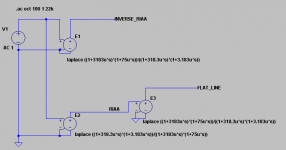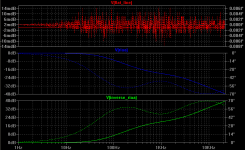Use the forum search function and lookup the terms laplace ltspice and you will find a few posts. The gist of it is to insert a voltage dependent voltage source (E) whose value is set to a string of the form
laplace ((1+3183u*s)*(1+75u*s))/((1+318.3u*s)*(1+3.183u*s))
You'll have to check the formula above because I wrote it from memory and I don't trust my memory.
In ltspice, to set the value of any component you press the CTRL key and in the same time press the right mouse button on top of the component. That will open a dialogue, and you need to change the "value" field.
laplace ((1+3183u*s)*(1+75u*s))/((1+318.3u*s)*(1+3.183u*s))
You'll have to check the formula above because I wrote it from memory and I don't trust my memory.
In ltspice, to set the value of any component you press the CTRL key and in the same time press the right mouse button on top of the component. That will open a dialogue, and you need to change the "value" field.
Last edited:
tnx, i'm still a bit "fuzzy" about the use of laplace sources, that helps a lot for me too.
ra7 when you get ready to test your phono preamp with physical test equipment, the circuit i provided above goes in front of the phono preamp (between the sig gen and the phono preamp) and approximates (+/- 0.1db) the pre-emphasis curve of the laplace inverse riaa sig source.
ra7 when you get ready to test your phono preamp with physical test equipment, the circuit i provided above goes in front of the phono preamp (between the sig gen and the phono preamp) and approximates (+/- 0.1db) the pre-emphasis curve of the laplace inverse riaa sig source.
Right click on the input voltage source and enter "AC 1" into the box labeled "AC Amplitude".
Then go so Simulate->Simulation cmd->AC Analysis
I usually choose "decade" with 10 points per decade.
- keantoken
That will give you the closed loop response. For the open loop response (for determining stability) see LoopGain.asc and LoopGain2.asc in the ...LTSpiceIV/examples/Educational directory.
both have references, find them on the web and read them for understanding.
*sym=tl431
.subckt tl431 7 6 11
* k a fdbk
.model dclamp d (is=13.5n rs=25m n=1.59
+ cjo=45p vj=.75 m=.302 tt=50.4n bv=34v ibv=1ma)
v1 1 6 2.495
r1 6 2 15.6
c1 2 6 .5u
r2 2 3 100
c2 3 4 .08u
r3 4 6 10
g2 6 8 3 6 1.73
d1 5 8 dclamp
d2 7 8 dclamp
v4 5 6 2
g1 6 2 1 11 0.11
.ends
.subckt tl431 7 6 11
* k a fdbk
.model dclamp d (is=13.5n rs=25m n=1.59
+ cjo=45p vj=.75 m=.302 tt=50.4n bv=34v ibv=1ma)
v1 1 6 2.495
r1 6 2 15.6
c1 2 6 .5u
r2 2 3 100
c2 3 4 .08u
r3 4 6 10
g2 6 8 3 6 1.73
d1 5 8 dclamp
d2 7 8 dclamp
v4 5 6 2
g1 6 2 1 11 0.11
.ends
Does anyone have a spice model for a TL431 programable precision reference??? Or know where to find it??
Here's the one from the LTspice user's group, by analogspiceman. It takes into account stability, variation of impedance with frequency, etc.
Edit: This is for LTspice only, as it uses the semi-ideal diode model that's unique to LTspice.
Attachments
Last edited:
Hola and Thanks Y'all
I guess I'll see if I can figure out how to use it now that I Have it. I am trying to relpace a zener with a TL431. LT has a ltspice model for a lt1431 which is the 8 legged version of the simpler 3 pinned one. The TI site has a modeling excel program that lets you put in working voltage and target voltage to find component values thats pretty nifty...
Thanks again friends, Elwood
I guess I'll see if I can figure out how to use it now that I Have it. I am trying to relpace a zener with a TL431. LT has a ltspice model for a lt1431 which is the 8 legged version of the simpler 3 pinned one. The TI site has a modeling excel program that lets you put in working voltage and target voltage to find component values thats pretty nifty...
Thanks again friends, Elwood
i have a paper i was writing about damping factor, output impedance and feedback. all of the simulations and experiments so far are LTSpice models, i'm currently working on "part 2" which uses real physical equipment to verify the models, but i think everybody here could benefit from what i have so far. i'll post it later and get some feedback if anybody is interested. i can then post it on the wiki
how about i post it here first for review, so everyone can take a look at it and give me some feedback (pun intended ). there are some explanations in there about how to use and modify the parameters for the "generic" LTSpice op amp (GBW, Aol, which in itself can be very instructional.
). there are some explanations in there about how to use and modify the parameters for the "generic" LTSpice op amp (GBW, Aol, which in itself can be very instructional.
i have it as a pdf, but at 1.3Mb, was far beyond the upload limit, so i uploaded the .doc in a zip file
one immediate side benefit of writing this paper, is i can tell if a solid state amp is at least working somewhat normally, without applying signal, just by tapping on the speaker cone while i power it up and listening for the change in speaker damping. obviously this trick only works if the output impedance of the amp is significantly lower than that of the speaker, so it doesn't work with most tube amps or most class D amps (class D amps with ample feedback mechanisms are few and far between).
i have it as a pdf, but at 1.3Mb, was far beyond the upload limit, so i uploaded the .doc in a zip file
one immediate side benefit of writing this paper, is i can tell if a solid state amp is at least working somewhat normally, without applying signal, just by tapping on the speaker cone while i power it up and listening for the change in speaker damping. obviously this trick only works if the output impedance of the amp is significantly lower than that of the speaker, so it doesn't work with most tube amps or most class D amps (class D amps with ample feedback mechanisms are few and far between).
Attachments
- Status
- This old topic is closed. If you want to reopen this topic, contact a moderator using the "Report Post" button.
- Home
- Design & Build
- Software Tools
- Things you should know about LTSpice

